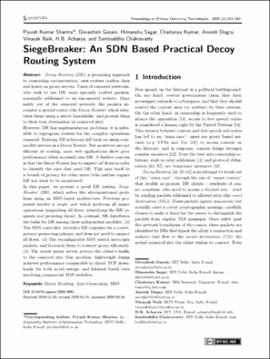| dc.contributor.author | Sharma, Piyush Kumar | |
| dc.contributor.author | Gosain, Devashish | |
| dc.contributor.author | Sagar, Himanshu | |
| dc.contributor.author | Kumar, Chaitanya | |
| dc.contributor.author | Dogra, Aneesh | |
| dc.contributor.author | Naik, Vinayak | |
| dc.contributor.author | Acharya, HB | |
| dc.contributor.author | Chakravarty, Sambuddho | |
| dc.date.accessioned | 2024-01-17T19:23:51Z | |
| dc.date.available | 2024-01-17T19:23:51Z | |
| dc.date.issued | 2020-07-13 | |
| dc.identifier | oksd_sharma_siegebreaker_an_sdn_based_2020 | |
| dc.identifier.citation | Sharma, P.K., Gosain, D., Sagar, H., Kumar, C., Dogra, A., Naik, V., Acharya, H.B., Chakravarty, S. (2020). Siegebreaker: an SDN based practical decoy routing system. Proceedings on Privacy Enhancing Technologies, 2020(3), pp. 243-263. https://doi.org/10.2478/popets-2020-0051 | |
| dc.identifier.issn | 2299-0984 | |
| dc.identifier.uri | https://hdl.handle.net/11244/340118 | |
| dc.description.abstract | Decoy Routing (DR), a promising approach to censorship circumvention, uses routers (rather than end hosts) as proxy servers. Users of censored networks, who wish to use DR, send specially crafted packets, nominally addressed to an uncensored website. Once safely out of the censored network, the packets encounter a special router (the Decoy Router) which identifies them using a secret handshake, and proxies them to their true destination (a censored site). | |
| dc.description.abstract | However, DR has implementation problems: it is infeasible to reprogram routers for the complex operations required. Existing DR solutions fall back on using commodity servers as a Decoy Router. But as servers are not efficient at routing, most web applications show poor performance when accessed over DR. A further concern is that the Decoy Router has to inspect all flows in order to identify the ones that need DR. This may itself be a breach of privacy for other users (who neither require DR nor want to be monitored). | |
| dc.description.abstract | In this paper, we present a novel DR system, SiegeBreaker (SB), which solves the aforementioned problems using an SDN-based architecture. Previous proposals involve a single unit which performs all major operations (inspecting all flows, identifying the DR requests and proxying them). In contrast, SB distributes the tasks for DR among three independent modules. (1) The SDN controller identifies DR requests via a covert, privacy preserving scheme, and does not need to inspect all flows. (2) The reconfigurable SDN switch intercepts packets, and forwards them to a secret proxy efficiently. (3) The secret proxy server proxies the client’s traffic to the censored site. Our modular, lightweight design achieves performance comparable to direct TCP downloads, for both in-lab setups, and Internet based tests involving commercial SDN switches. | |
| dc.format | application/pdf | |
| dc.language | en_US | |
| dc.publisher | Privacy Enhancing Technologies Symposium Advisory Board | |
| dc.relation.ispartof | Proceedings on Privacy Enhancing Technologies, 2020 (3) | |
| dc.rights | This material has been previously published. In the Oklahoma State University Library's institutional repository this version is made available through the open access principles and the terms of agreement/consent between the author(s) and the publisher. The permission policy on the use, reproduction or distribution of the material falls under fair use for educational, scholarship, and research purposes. Contact Digital Resources and Discovery Services at lib-dls@okstate.edu or 405-744-9161 for further information. | |
| dc.title | Siegebreaker: an SDN based practical decoy routing system | |
| dc.date.updated | 2024-01-12T21:49:56Z | |
| osu.filename | oksd_sharma_siegebreaker_an_sdn_based_2020.pdf | |
| dc.identifier.doi | 10.2478/popets-2020-0051 | |
| dc.description.department | Computer Sciences | |
| dc.type.genre | Conference proceedings | |
| dc.type.material | Text | |
| dc.subject.keywords | distributed computing and systems software | |
| dc.subject.keywords | information and computing sciences | |
| dc.subject.keywords | cybersecurity and privacy | |
| dc.identifier.essn | 2299-0984 | |
